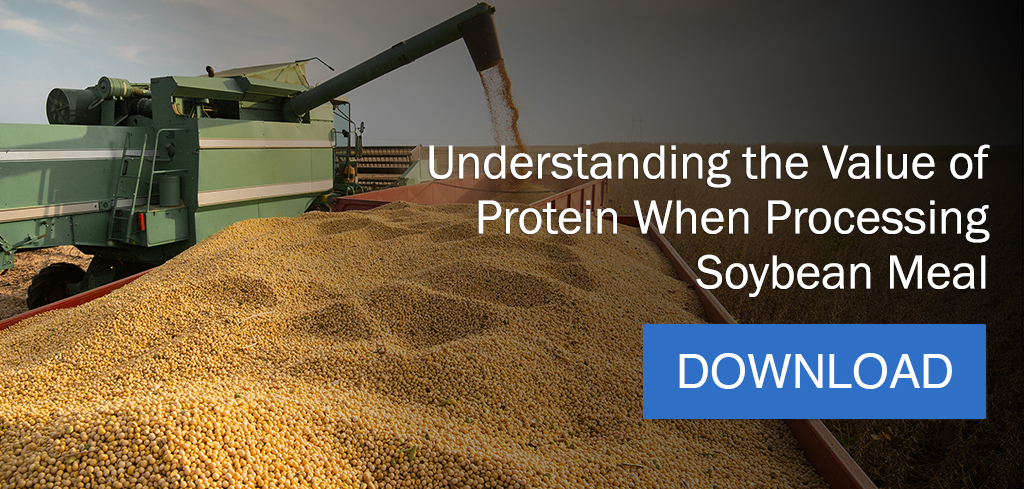
About 98% of the world’s soybean meal is used as animal feed, supplying essential nutrients to poultry, swine, livestock, fish, and pets around the world. What makes this byproduct leftover from soybean oil extraction vital for animals’ daily diets? In a word: protein. The value of any oilseed meal is determined by the quality of the protein it contains, and the unique profile of soybean meal protein has become the “gold standard” by which other protein sources are measured.
Boasting a rich concentration of highly digestible amino acids and palatable proteins, soybean meal offers unmatched nutritional value for various species. By examining the chemical makeup of these proteins, processors can better understand what makes soybean meal protein so valuable in global feed formulations—and appreciate the many factors that can impact protein quality during processing.
The building blocks of life
Proteins are vital to our existence because they direct the structure and activity of every cell inside every living organism. From muscle growth and digestion to delivering oxygen as we breathe, proteins are the catalysts that regulate every function and reaction in our bodies.
While proteins are the building blocks of life, the building blocks of proteins are called amino acids. The molecules in amino acids bond together, forming long chains that fold and coil into helix-like structures. The sequence of amino acids and the bonds between their chains determine the shape of each protein—leaving certain compounds exposed to interact with other molecules. The function of each protein is guided by the way these exposed surfaces interact with other molecules as a result of this shape.
Although hundreds of amino acids exist in nature, 20 standard amino acids are commonly formed into proteins. All of these 20 amino acids are vital to cellular function, and humans and animals naturally synthesize some of them on their own. However, there are nine essential amino acids that the human body can’t synthesize, so they must be consumed through other sources of protein.
This gap is what makes soybean meal protein so “essential” to animal feed formulations. With a high concentration of protein ranging from 44% to 49%, soybean meal contains more essential amino acids than any other protein source. Plus, these amino acids are highly digestible, especially for nonruminants like swine and poultry. Soybean meal protein is particularly rich in lysine, tryptophan, threonine, isoleucine, and valine—the essential amino acids typically lacking in corn and other grains commonly fed to these animals. In fact, soybean meal contains more than twice as much lysine as oats, wheat, corn, or grain sorghum, not to mention many other types of oilseed meals.
Unfolding protein structures
Why should oilseed processors worry about the chemical makeup of proteins when they’re just trying to separate the oil from the meal? Processors need to realize that the raw materials they’re handling and the processing methods they’re using significantly impact the resulting soybean meal protein quality. Seed genetics, growing conditions, storage facilities, moisture levels, particle size, and other steps taken during extraction determine the amino acid profile of the soybean meal produced.
For example, heat applied to soybeans throughout processing can unfold the protein structures, causing what’s known as denaturation. Heat treatment changes the shape of the protein, which can limit its functionality. Cooking an egg is a prime example of this transformation: the runny egg white becomes solid and opaque when exposed to heat, permanently changing its physical structure. The same thing happens to soybean meal protein when heat is applied.
Denaturation can be good or bad, depending on the type of protein being transformed. For example, heat treatment is critical to deactivate harmful enzymes like trypsin inhibitors and urease, which are naturally occurring proteins in soybeans that can interfere with digestion. However, excessive heat exposure can damage essential amino acids that animals need, degrading the nutritional value of the meal.
Processors must pay close attention to heat throughout the extraction process, as each degree and minute of exposure can pose a risk to soybean meal protein quality. Consider processing steps such as:
- Drying seeds to remove excess moisture
- Extruding seeds to prepare for extraction
- Pressing seeds to extract the oil from the meal
Even without applying direct heat, mechanical screw presses like the Anderson Oil Expeller® generate frictional heat while crushing seeds. This heat alone might not be sufficient to destroy trypsin inhibitors. At the other extreme, traditional oilseed cookers expose soybeans to high temperatures for up to 30 minutes, which can over-roast the meal and denature essential amino acids like lysine.
The Anderson Dox™ Extruder achieves the perfect balance by quickly cooking seeds upstream of the press with a short residence time of only 20 to 30 seconds, preserving the quality of the proteins while effectively deactivating the anti-nutritional factors.
Optimizing soybean meal protein quality
Striking the perfect balance of heat treatment during soybean processing can be tricky, but processors can use a combination of different tests to measure protein quality. Some methods, like the protein solubility test and the protein dispersibility index, can detect whether soybean meal protein has been over-processed with excessive heat—while others, like the urease activity test, help identify meal that has been under-processed.
The key is to measure soybean meal protein quality regularly to monitor heat exposure and other processing conditions that can potentially cause denaturation. A comprehensive process audit from Anderson International can help analyze your processing system by collecting samples along the way to pinpoint specific steps you can take to optimize protein quality.
By addressing these factors, processors can boost the value of their soybean meal to achieve the “gold standard” of essential proteins that animals around the world depend on.
To learn more, download Anderson’s guide to soybean meal protein.

